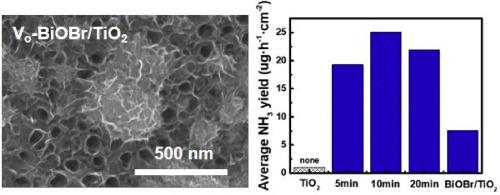International Journal of Hydrogen Energy ( IF 8.1 ) Pub Date : 2022-03-02 , DOI: 10.1016/j.ijhydene.2022.02.026 Sheng Lin 1 , Yinhuan Chen 1 , Jiangjian Fu 1 , Lan Sun 1, 2 , Qiaorong Jiang 1 , Jian-Feng Li 1 , Jun Cheng 1 , Changjian Lin 1 , Zhong-Qun Tian 1

|
Photocatalytic or photoelectrocatalytic nitrogen fixation is considered as a very promising way to reduce energy requirements. Here, Vo-BiOBr/TiO2 nanocomposite photoelectrode was constructed by modifying TiO2 nanotube arrays with BiOBr nanosheets with oxygen vacancies (Vo) for photoelectrocatalytic nitrogen fixation. The oxygen vacancy promotes the adsorption and activation of N2 on the catalyst surface. The Lewis basicity of nitrogen is enhanced by transferring the photogenerated electrons on the conduction band of BiOBr to the π anti-bonding orbit of N2, which is more beneficial for the addition of protons. On the other hand, the heterojunction between TiO2 and Vo-BiOBr facilitates the separation of photogenerated carriers. The photogenerated holes on the valence band of TiO2 travelled to the counter electrode to produce oxygen at a negative potential, avoiding the further oxidation of NH3. Vo-BiOBr/TiO2 displays a high NH3 production rate of 25.08 μg h−1 cm−2 at −0.2 V which is 3.3 times higher than that of BiOBr/TiO2. The synergistic effect between TiO2 and Vo-BiOBr results in enhanced light absorption and higher photoelectrocatalytic efficiency for the N2 reduction reaction.
中文翻译:

Vo-BiOBr/TiO2异质结构光电极作为光催化剂的光电催化固氮
光催化或光电催化固氮被认为是一种非常有前途的降低能源需求的方法。在这里,通过用具有氧空位 (V o ) 的BiOBr 纳米片修饰 TiO 2纳米管阵列来构建 V o -BiOBr/TiO 2纳米复合光电极,用于光电催化固氮。氧空位促进了N 2在催化剂表面的吸附和活化。通过将BiOBr导带上的光生电子转移到N 2的π反键轨道上,提高了氮的路易斯碱度,更有利于质子的加成。另一方面,TiO 2之间的异质结和 V o -BiOBr 促进光生载流子的分离。TiO 2价带上的光生空穴行进到对电极以产生负电位的氧气,避免了NH 3的进一步氧化。V o -BiOBr/TiO 2在-0.2 V时表现出25.08 μg h -1 cm -2的高NH 3生产率,是BiOBr/TiO 2的3.3倍。TiO 2和V o -BiOBr之间的协同作用导致增强的光吸收和更高的N 2还原反应的光电催化效率。











































 京公网安备 11010802027423号
京公网安备 11010802027423号